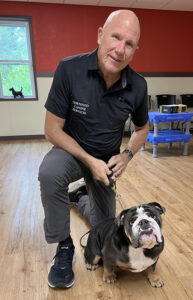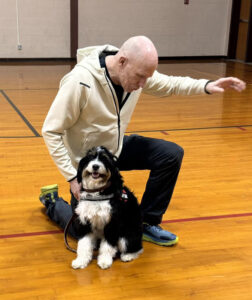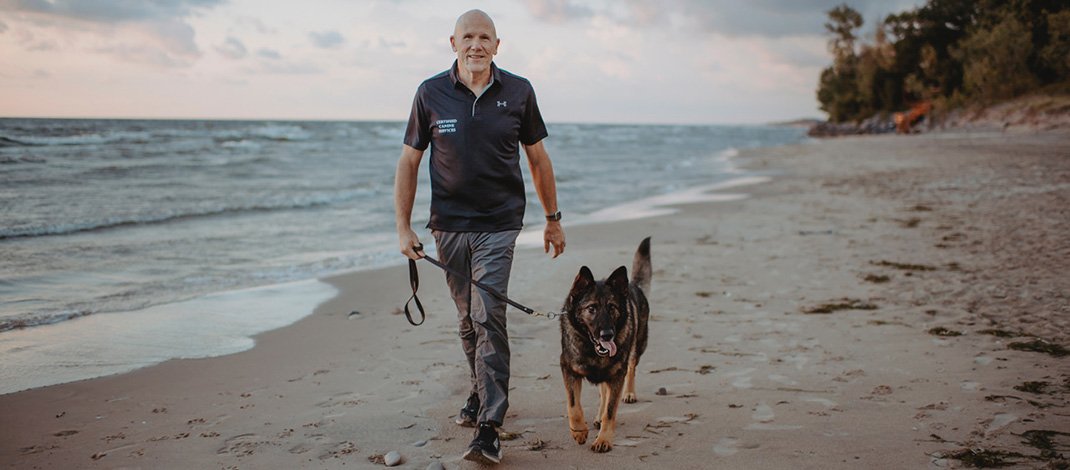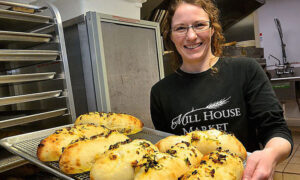Sandy Creek-based trainer has helped train dogs of celebrities like Brooke Shields, Sean McDermott of the Buffalo Bills and Beth Baldwin
By Stefan Yablonski

After training more than 6,000 — Neil Mathews knows dogs.
Mathews, owner and trainer at Certified Canine Services in Sandy Creek, was 12 years old when he saw a program on TV about dog training. He started to try the techniques on his family’s Boxer, Misty. Because he was 12 — “it was fun, but the results limited.”
His interest in training continued. In 1997, Mathews graduated from the National K-9 School for Dog Trainers in Columbus, Ohio. He completed the master trainer’s course and was certified in basic and advanced obedience, puppy development, behavior modification, basic police K-9 and other training methods.
“We know how to push your dog’s buttons to see if he or she has what it takes to be a service dog. Not all dogs can be service dogs and not all dogs make good hunting dogs,” he cautioned.
He worked at Stickley Furniture for about 11 years, he said.
“We have been here [at 8166 state Route 3) since 2011. We are actually in the town of Sandy Creek. We built this ourselves. We were closed from the previous place, which was over on 62 just out of Pulaski [for about five years]. Previous to that, we were over in Altmar for five or so years. That’s where we were when we became Certified Canine Services, when I opened the business. We were closed for a couple months while we were building this. We were rushing to open,” he explained.
“We do basically everything; the majority — our bread and butter — is just family pets. We are doing more and more service dogs and therapy dogs, a lot for schools,” he added.
Mathews has worked with some famous names. “We trained Brooke Shields’ two dogs for six weeks. We did a dog for Sean McDermott [of the Buffalo Bills],” Matthews said. “And there’s been a few others.”
His wife, Rachel, could almost always be found surrounded by animals growing up. Her interest in training began when she was looking for a trainer for her dog, Brutus, a rottweiler “with some aggressive tendencies.” She is a 2007 graduate of the National K-9 School for Dog Trainers.
“Neil and I met when I started working with him 14 years ago. We have 10 therapy dogs for different schools right now and we do service dogs for a program called Victory For Vets in Syracuse,” Rachael said. “We also have several dogs for Children’s Miracle Network [service dogs for children] and we get quite a few phone calls — people want a therapy dog for private practice.”
“We actually have a therapy dog for a school in New Jersey,” Matthews added. “And we are doing one right now, Emmett, a therapy dog for a dentist in Wilmington, North Carolina. We’re training a dog currently for the Oswego City Police Department.”
Certified Canine Services’ staff includes trainers Brad Dawley, a 2017 graduate, and Desiree Haynes, who graduated in February 2023.
Brooke Whitaker is the puppy development program trainer — “she has had a soft spot for puppies ever since she could walk.” She grew up watching her parents operate Certified K-9 and has been involved with puppies and dogs from an early age. Her goal is to get puppies off to the best possible start for a smooth transition to their new homes. The most difficult thing for her is giving the puppies back after she “falls in love with each one of them.”
Roberta Tousant is the kennel attendant.
Is it tougher to train a certain breed?

“No — it’s not the breed, it’s the personality. There are six different personalities. So the dogs that are struggling, whether it is aggressive or separation anxiety or scared — it’s always about the personality. It’s not the breed,” Matthews explained. “Those different personalities you find in every breed. That is actually what we train to here; that’s what we look at. Aggressive, fear biter, shy, hyper, basket case and”… “happy go lucky,” Rachel added.
“There is a difference between them, but many of the dogs — most all of them actually — we’ll see one that is happy go lucky and hyper. They have a lot of energy. What we see more than anything, I think, is dogs that people think are aggressive that don’t truly have an aggressive personality, they’re fear biters. They might be acting out aggressively, but they are doing it out of fear — they’re scared, the environment that they are in is making them nervous so they are barking and lunging and doing all these things,” Matthews said.
If you see a big rotweiller and he’s barking and carrying on and everything — you think first of all it’s a rotweiller so they are scary and mean and everything, he said as an example.
“I would say of every breed we’ve ever trained, we’ve seen big teddy bears … pit bulls, they get a bad rap because they can do so much damage. But we’ve seen pit bulls that are absolutely darlings, just sweet, adorable and loving puppies — everything you’d want in a dog.”
Bad bites
“We have had bites, bad bites. Probably the worst bite I’ve ever had was from a basset hound,” Matthews said. “That’s an example. It wasn’t because he was a basset hound. It was because he truly had an aggressive personality. When you get bit, it’s not the dog’s fault — it’s our fault, the trainers. We weren’t paying attention.”
“Sometimes, it is the way we raise small dogs,” Rachel said. “People do a lot of stuff with smaller dogs that you can’t do with bigger dogs. With bigger dogs, people tend to get rules set in place right away. But with little dogs, people will carry them around in their purse, dress them up and kind of privilege them and it confuses the dogs; so it creates a dog that has fear and anxiety … they’re treated like a child and not a dog and it confuses the dog.”
Training people, that is part of the program that goes with every dog, Matthews said.
“The dog stays here. It’s a camp program. So if you have a dog and you want him trained, you bring him here and you drop him off for depending on the dog, how old it is and what it’s being trained for, anywhere from two weeks to six or eight weeks and you wouldn’t see the dog during that time.”
“There are a couple video lessons the owner does while their dogs are here,” Rachael said. “Then when they pick them up, we do about an hour an hour and a half session going over what the dog learned, how they did.”
The first couple weeks they “install the language.”
“In other words, you have a way to communicate with the dog — sit, down, heel, come and the word ‘no,’ that’s the most important thing,” Matthews said. “When we look at a dog and we say ‘no’ that is in a disappointed tone NOT an angry tone — there is a big difference. You should always sound disappointed, not angry.”
“When a dog does something and we say ‘no’ they think, ‘OK, what I’m doing right now is wrong,’” he said. “That is what we work on the first couple weeks and once that language is installed then we start to set them up —– we put them in situations where maybe they’re not going to want to listen (the cats walking by or other dogs around for examples).”
“Once they’re good to do that and still responding, then we start going to town with them and taking them to stores and doing things with them. We even go to Lowe’s in Oswego. We load up a couple vans with dogs and go up there,” he added.
Favorites
They have several “favorite breeds.”
“Rachael and I have a German shepherd, which is one of my favorite breeds,” Matthews said.
“You can get one that is just perfect. But there are some that are, unfortunately, just a wreck, for a variety of reasons,” Rachael added. “Our dog’s name is Ramzi. We just really like the ring of his name.”
“Doodles” make great therapy dogs and service dogs — they’re just perfect for that, she added.
“We see so many dogs and sometimes they are just mutts, but you’re just drawn to them and you’re like ‘I would have this dog for my own!’ It’s just because of the dog’s personality,” Matthews said. “Every single dog, I guarantee I can find a high strung dog in that breed. It is the way it is.”
“It’s kind of like having siblings. You can have four sisters and they are all different,” Rachael said.
Green room = fun
The Green Room has artificial carpeting; waste just drains right through and there is stone underneath it so the dogs can come out here and go to the bathroom wherever they want and we can just take the hose and spray it away. It makes it feel like they are outside, Matthews explained.
“We test them first to make sure that they are OK with other dogs,” he said. “Every morning first thing when we open up they all come out here run around and get exercise — we call it the social.”
That’s when the kennels are being cleaned. Then the dogs go in and they have breakfast.
Another social is in the afternoon around 12:30 or 1, right after lunch.
“The dogs all come back out run around, play, have a good time. So they understand it’s not just about the training; you’re not just here for obedience or whatever it is we’re teaching — you can have a good time, too. Socializing is an important part of the training. It helps them to relieve stress because being here is stressful, it just is. They are in a boarding environment, their owners have left them, they are being trained very intensely and more than they are used to in their daily lives,” Matthews said.
“This gives them a chance to kind of relieve that stress and just run around and play. We found that it just makes it so much better for them for their stay,” he added. “It is heated and air-conditioned so we can use it year-round no matter what the weather is outside. We also use the room for training. We’ll bring a dog out and do some obedience training.”
Beth Baldwin: Certified Canine is ‘Worth the Drive’
Beth Baldwin from Camillus got a new puppy about a year and a half ago.
“My daughter also brings her dog here and she said what excellent training they have. So I am willing to take that hour and 15 minute drive to come all the way out here,” she said. “You get the boarding and the extra training while the dog is here and I think that is great.”
Her puppy “needs a little boot camp while she is here,” Baldwin quipped.
“I don’t do the boot camp at home all the time — we pamper her more,” she said. “I think we all do that. It’s like kids, we kind of let them get away with you-know-what and then when I bring her back out here I know they’ll take care of her.”
Baldwin — the sister of actors Alec, Daniel and Stephen Baldwin — said she has had this breed awhile.“I have had four of them. We lost two dogs that were six months apart. They lived to 14, but they died exactly a year apart on the same day. My mom went behind my back and ordered this puppy,” she said.
“My mom [Carol] was 92. She died. So my mom picked out this puppy online and she died. So it was her wake, her funeral and the next day we went to pick up the puppy. My 16 grandchildren named the puppy. My mother was Gram to them and she was a Baker — so the puppy’s name is GrahmCracker Baldwin. My mother was an activist for breast cancer. We thought it was cute to name the puppy G R A H M with a cracker on it.”




